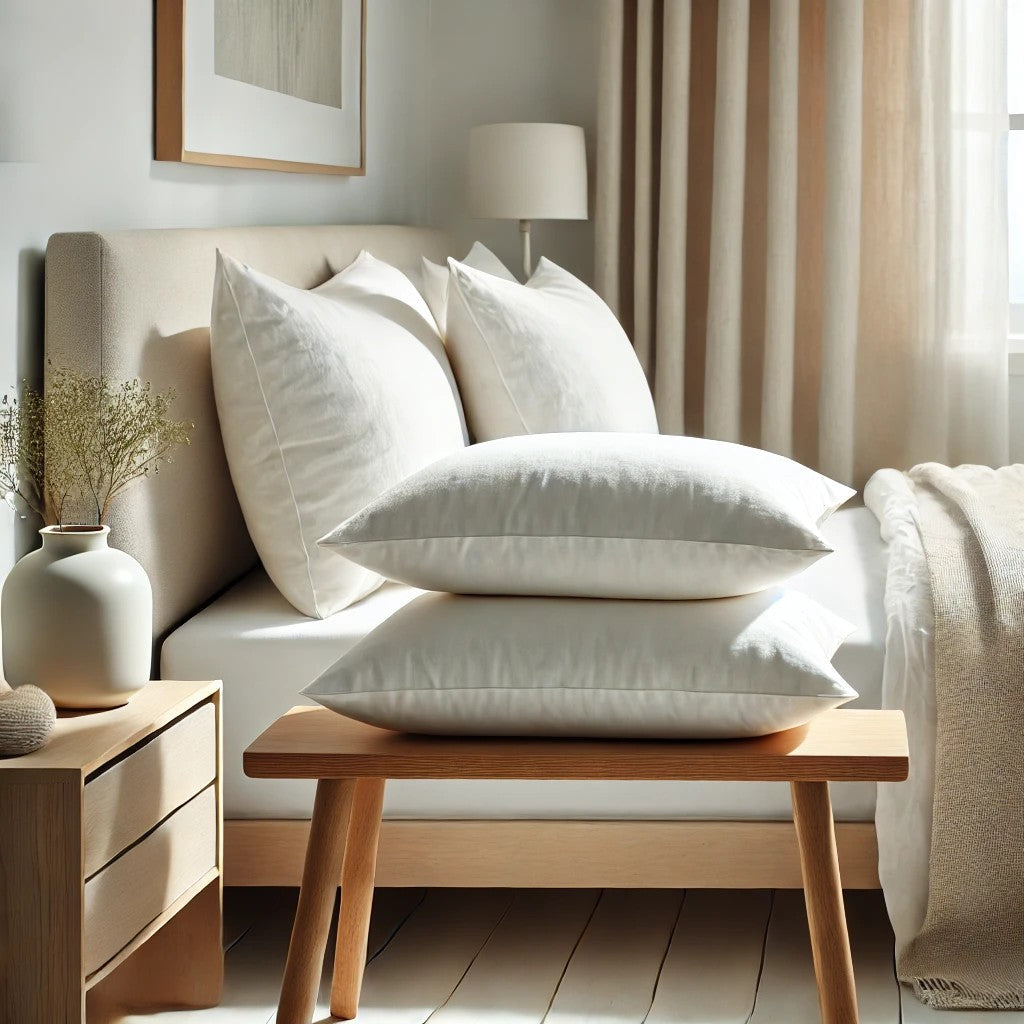If the bedroom is a sanctuary, then the bed is the inner sanctum. It’s the place of refuge, rest, and restoration - in particular, the pillow. That’s where our skin, hair, and lungs spend roughly 7 to 9 hours every night. But hidden inside even the plushest pillow is something far less relaxing: dust mites.
Dust mites in pillows are incredibly common, and while they are invisible to the eye, they can have a real impact on health, especially for people sensitive to allergens or who have asthma. Here’s what to know about dust mites in pillows and how to create a cleaner, more breathable bedroom environment.
What Are Dust Mites?
Dust mites are microscopic insects that thrive in warm, humid environments, especially where dead skin cells are abundant. Since humans shed millions of skin cells each night, pillows and mattresses become ideal locations for these tiny creatures, making them very common. It is estimated that roughly 4 out of 5 homes have at least 1 bedroom that contains dust mites (1).
They don't bite or sting, but the proteins in their waste and bodies can trigger allergic reactions, particularly in people with pre-existing sensitivities. According to the American Lung Association, exposure to dust mite allergens is a leading cause of indoor-based allergies (2).
Signs You May Have Dust Mites in Your Pillows
Because dust mites are microscopic, you will not be able to see them, but you may notice signs of their presence, especially in the morning or after extended time in bed.
Common symptoms include:
- Congestion or stuffy nose
- Sneezing, especially upon waking
- Watery or itchy eyes
- Coughing
- Itchy nose or roof of mouth
- Mild facial pressure or pain (3)
If your symptoms improve when you leave your home or worsen after making the bed, it’s a strong sign your bedding may be a factor.
Why Pillows Are a Dust Mite Hotspot
Pillows are warm, absorbent, and often overlooked in routine cleaning. Many traditional pillow materials, such as down or synthetic polyester fill, trap heat and moisture, creating an ideal environment for dust mites to thrive.
Furthermore, some common pillow surfaces retain moisture, such as cotton, which can encourage a dust mite-friendly environment.
7 Tips to Reduce or Eliminate Dust Mites in Pillows
The good news? You don’t need to toss your entire bedding setup. There are several simple and effective strategies to reduce dust mite buildup and create a cleaner sleep environment.
-
Choose Hypoallergenic Pillow Materials
Opt for pillows and pillowcases made from natural, non-porous, and breathable fabrics like silk or bamboo. These materials make it harder for dust mites to burrow and multiply, plus they have the added benefit of being naturally hypoallergenic.
-
Wash Bedding Frequently
Wash your pillowcases and sheets at least once a week in hot water (130°F / 54°C) to kill mites and remove allergens. For silk pillowcases, follow care instructions that allow for effective cleaning while preserving the fabric's integrity.
-
Consider a Copper-Infused Pillowcase
Studies have shown that copper-oxide impregnated fabrics significantly decrease the mobility and vitality of dust mites. A 2008 study found mortality rates of dust mites between 95-100% after exposure to fabrics with copper oxide levels of 0.4-2% (4). Just a small amount of copper infused into fabrics had a significant impact on reducing dust mite populations.
-
Try a Pillow Protector
An encasement (it may also be called a pillowcase liner) made of tightly woven fabric creates a physical barrier between your pillow and allergens. Look for protectors labeled as “dust mite-proof” or “allergen barrier.”
-
Replace Pillows Regularly
Most experts recommend replacing pillows every 1 to 2 years, as dust mites and their waste accumulate over time. If your pillow has lost its shape, smells musty, or hasn’t been cleaned properly, it’s probably time for an upgrade.
-
Lower Bedroom Humidity
Dust mites thrive in humidity above 50%. Using a dehumidifier or keeping your room’s humidity between 30–50% can significantly reduce dust mite populations.
-
Vacuum and Dust Regularly
Use a vacuum with a HEPA filter to clean around your bed, including headboards, carpets, and nightstands, where allergens can collect. Also, consider removing heavy drapes or rugs that trap dust.
The Added Benefits of Copper-Infused Textiles
Beyond being soft and luxurious, copper-infused silk pillowcases offer an added wellness edge. Copper has been shown to possess antimicrobial properties that can help reduce bacterial buildup on fabric surfaces. While copper textiles haven't been directly studied for their impact on dust mite populations, their resistance to microbial growth makes them a smart, low-maintenance option for those concerned with pillow hygiene.
Furthermore, copper-infused fabrics have also been demonstrated to support a reduction in fine lines and crow’s feet, and to improve skin elasticity,.
Final Thoughts: Clean Pillows, Clear Sleep
Your pillow is the closest thing to your face for a third of your life, so keeping it clean and breathable matters more than you might think. By understanding how dust mites affect pillows and taking proactive steps to minimize their presence, you create a healthier, more restorative sleep environment.
At Copper North, we’re committed to making products that support well-being, naturally. From copper-ionized silk pillowcases to clean, breathable textiles, we help you build a bed that is as hygienic as it is luxurious.
See these other tips for building a stylish, healthy bedroom:
- The Best Bedding for Teenagers: Comfort, Style, and Skin-Friendly Choices
- The Ultimate Guide to Pillowcases: Finding the Perfect Fit for Your Bed
References
- Arbes, S., et al. (2003). “House dust mite allergen in US beds: Results from the first national survey of lead and allergens in housing”. The Journal of Allergy and Clinical Immunology. Volume 111, Issue 2p408-414. Link
- American Lung Association. 2025 (Updated: April 22, 2025, Accessed April 24, 2025). “Dust Mites”. Link
- Mayo Clinic. (Updated: July 31, 2021, Accessed April 19, 2025) “Dust Mite Allergy”. Link
- Mumcuoglu, K. et al. (2008). “Copper oxide-impregnated fabrics for the control of house dust mites.” International Journal of Pest Management. 54(3):235-240. Link
- Baek, J. et al. (2012). “Reduction of facial wrinkles depth by sleeping on copper oxide-containing pillowcases: a double blind, placebo controlled, parallel, randomized clinical study.” Journal of Cosmetic Dermatology. 1473-2165.2012.00624.x Link
- Dykes, P. (2014). “Increase in skin surface elasticity in normal volunteer subjects following the use of copper oxide impregnated socks.” Skin Research and Technology. 10.1111/srt.12187. Link





Share:
Copper and Anti-Aging: How This Mineral Supports Skin Rejuvenation